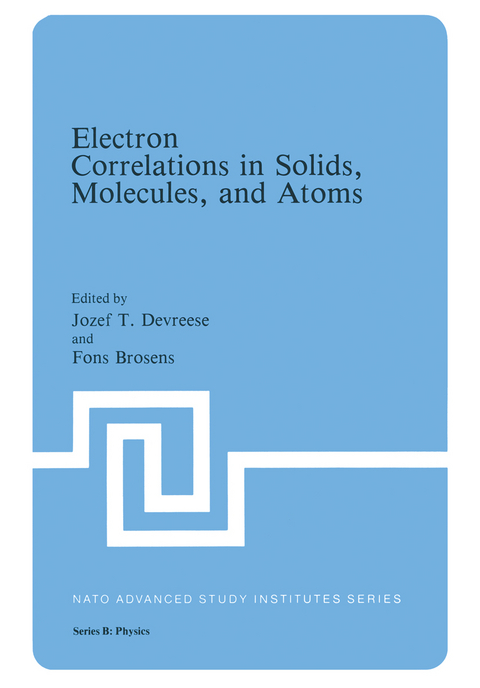
Electron Correlations in Solids, Molecules, and Atoms
Kluwer Academic/Plenum Publishers (Verlag)
978-0-306-41027-7 (ISBN)
- Titel z.Zt. nicht lieferbar
- Versandkostenfrei innerhalb Deutschlands
- Auch auf Rechnung
- Verfügbarkeit in der Filiale vor Ort prüfen
- Artikel merken
Determination of S(q,?) by Inelastic Electron and X-ray Scattering.- Random phase approximation.- Static screening.- Finite frequency, small wave vector response.- Ultraviolet optical properties.- Inelastic electron scattering.- Beyond the random phase approximation.- Physical meaning of the function parameters.- High q measurements.- Stronger periodic fields.- Collective effects in atoms: a test case.- References.- Charge Density Wave Phenomena in Potassium.- I. The mysteries of the simple metals.- II. Phasons: what they are and what they do.- III. Theory of charge density waves.- References.- Electron-Hole Liquid: Role of Correlations.- I. Introduction.- II. What is an electron-hole liquid?.- III. Is the plasma phase more stable than the excitonic phase?.- IV. Ground state energy of EHL in Ge.- V. EHL in stressed Ge.- VI. Phase separation of “Hot” and “Cold” liquids.- VII. Remarks on correlations in a model e-h system.- References.- Kinetic Equations and Two-particle Correlations in the Homogeneous Electron Liquid.- 1. Basic definitions and formulas.- 2. Wigner distribution functions and the kinetic equations.- 3. Approximate decoupling procedures for the two- particles Wigner function.- 4. The kinetic equation for the two-particle Wigner function and some exact asymptotic formulas.- 5. Dynamic properties and the Mori formalism.- References.- Dynamical Exchange Effects in the Dielectric Function of the Electron Gas.- I: The jellium model: elementary concepts.- II: Dielectric function of the electron gas with dynamical exchange decoupling.- III: Discussion and comparison with first-order perturbation theory.- Liquid Alkali Metals and Alkali-Based Alloys as Electron-Ion Plasmas.- 1. Introduction.- 2. Some results of electron screening for crystal-line metals.-3. Electron screening for liquid metals.- 4. Structure factor of liquid alkali metals.- 5. Thermodynamic properties of liquid alkali alloys by the method of long waves.- 6. Some other alkali-based liquids.- References.- Resistance minima in Magnetic Alloys.- I. Historical survey.- II. Kondo effect.- III. Resistance minimum for impurity pairs.- IV. Superconductivity.- V. Conclusions.- References.- Theory of Exchange-Correlation Effects in the Electronic Single- and Two-Particle Excitations of Covalent Crystals.- I. Introduction.- II. Many-body description of the two-particle excitations in periodic crystals: examples diamond and silicon.- III. Dynamical correlation effects in the electronic quasi-particle states of perfect crystals: example diamond.- IV. The influence of many-body effects on the screening of impurities in perfect crystals: examples diamond and silicon.- V. Summary and discussion.- References.- Collective Phenomena in Non-Uniform Systems.- 1. Introduction.- 2. Hydrodynamical oscillations of an inhomqgeneous electron gas.- 3. Extensions and simplifications of the hydro-dynamical model.- 4. Applications and critique of the hydrodynamical model.- 5. The response of a non-uniform system to an external field.- 6. Some many-body aspects of atomic-like systems.- 7. Linearized quantum equations for density oscillations.- 8. Density functional theory applied to photo-absorption.- References.- Dynamical Structure Factor of an Electron Liquid.- I. Introduction.- II. Formulation.- III. Numerical results.- References.- Author index.
| Reihe/Serie | NATO Science Series: B ; 81 |
|---|---|
| Zusatzinfo | 435 p. |
| Sprache | englisch |
| Themenwelt | Naturwissenschaften ► Physik / Astronomie ► Allgemeines / Lexika |
| Naturwissenschaften ► Physik / Astronomie ► Atom- / Kern- / Molekularphysik | |
| Naturwissenschaften ► Physik / Astronomie ► Festkörperphysik | |
| Naturwissenschaften ► Physik / Astronomie ► Thermodynamik | |
| ISBN-10 | 0-306-41027-3 / 0306410273 |
| ISBN-13 | 978-0-306-41027-7 / 9780306410277 |
| Zustand | Neuware |
| Haben Sie eine Frage zum Produkt? |
aus dem Bereich


